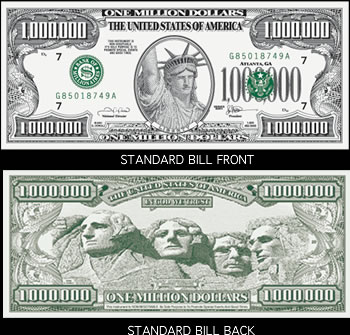
Posted on 10/20/2010 1:21:56 PM PDT by MissTed
Edited on 10/20/2010 3:16:14 PM PDT by Admin Moderator. [history]
LOWELL, Mass.
(Excerpt) Read more at comcast.net ...
If not mistaken, the largest bill used in general circulation was a one thousand dollar bill. All the larger denomination were used between banks.


I've only got a 500.
Cuz he’s as queer as a $3 bill. 3 x 3,333 = 9,999. Add one for $10K.
Ding ding ding!!!!!! Winner !!!!!!!!!!!! Although you forgot “ THE ONE” for good measure.....
BTW this person died 50 years ago at which time he was very old.
Yes there were, my understanding was that they were used largely by the banking system to facilitate large interbank funds transfers. Now such transfers are handled electronically with no exchange of paper notes. They were printed from 1865 to 1946 and allowed to circulate until 1969 at which time they were retired from circulation, with about 350 in various collections. The government no longer prints any bill larger then the one hundred.
Binion's Horseshoe Casino on Fremont Street in Las Vegas has a display of one hundred $10,000 bills on display in their lobby under two inches of bullet proof glass. That's about as close as 99.9% of visitors to Vegas will ever get to one million dollars.
Regards,
GtG
Binions actually sold off their 10,000 bill collection. A couple of years ago they were on Ebay and going for a LOT more than $10000 because they are so rare. I bought a $1000 dollar bill once for 1400.00.
At one time Italy had the largest per capita percentage of millionaires of any country in the world. You could drop 100,000 Lira on a good dinner out with your girl and a 1,000,000 Lira for a nice suit.
Regards,
GtG
My bad, according to this aticle the 10,000 was at one time in circulation.The other bills are printed in black and green as shown by the $10,000 example (pictured below). Although they are still technically legal tender in the United States, high-denomination bills were last printed in 1945 and officially discontinued on July 14, 1969, by the Federal Reserve System. [1] The $5,000 and $10,000 effectively disappeared well before then. Of the $10,000 bills, 100 were preserved for many years by Benny Binion, the owner of Binion’s Horseshoe casino in Las Vegas, Nevada, where they were displayed encased in acrylic. The display has since been dismantled and the bills sold to private collectors. Also, there is one large size, 1800s 1,000 dollar bill in the Birdcage Theater in Tombstone, Arizona underneath the glass counter top.
The Federal Reserve began taking high-denomination bills out of circulation in 1969. As of May 30, 2009, there were only 336 known $10,000 bills in circulation; 342 remaining $5,000 bills; and 165,372 $1,000 remaining bills.[2] Due to their rarity, collectors will pay considerably more than the face value of the bills to acquire them.
For the most part, these bills were used by banks and the Federal Government for large financial transactions. This was especially true for gold certificates from 1865 to 1934. However, the introduction of the electronic money system has made large-scale cash transactions obsolete; when combined with concerns about counterfeiting and the use of cash in unlawful activities such as the illegal drug trade, it is unlikely that the U.S. government will re-issue large denomination currency in the near future. According to the US Department of Treasury website, “The present denominations of our currency in production are $1, $2, $5, $10, $20, $50, and $100. Neither the Department of the Treasury nor the Federal Reserve System has any plans to change the denominations in use today.”[3]
Disclaimer: Opinions posted on Free Republic are those of the individual posters and do not necessarily represent the opinion of Free Republic or its management. All materials posted herein are protected by copyright law and the exemption for fair use of copyrighted works.